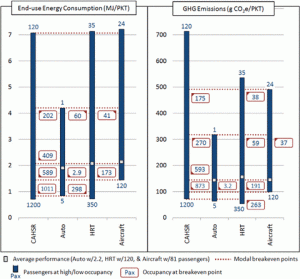QUESTION: High-speed trains have been in the news recently. I love modern trains, and those who share this view cite financial savings and pollution prevention. Others wonder if it is financially or ecologically sensible to run a line that distance. When, if ever, would a financial break-even point come? What would be the carbon debt to construct such a train line? Asked by Denny Brown, Boulder, Colo.
ANSWER: We have something in common: I love trains, too. In fact, one route I take once a year or so is from Seattle to Vancouver, BC. Not only is this trip beautiful, but taking the train eliminates the need to drive, saves me flying expenses and gives me twice the leg room I need. In addition, I always feel I am picking the most environmentally friendly option.

This last point is one of the reasons trains have been in the news so much lately. The Obama administration has made high-speed rail — trains traveling between 150 and 220 miles per hour — a legislative priority. On Nov. 3, 2010, the U.S. Department of Transportation allocated $2.4 billion to begin the development of high-speed rail corridors in 23 states. They expect these trains to connect economic centers, foster community and “reduce national dependence on oil.”
Sounds great so far, right? So when a paper came out in January 2010 suggesting these high-speed trains may not be as good for the environment as many claim, it created quite an uproar. To arrive at their controversial conclusion, the authors of the paper performed a life cycle assessment in which they analyzed energy use and carbon dioxide emissions from manufacturing, using and maintaining a high speed rail system on the proposed San Francisco to Los Angeles line. In fact, they considered many of the impacts you mentioned in your question. To put it simply, their conclusion was essentially that even the most efficient trains are not environmentally friendly if they are empty.

The good news is that their conclusion does not entirely dismiss high-speed rail. The complication, then, in determining an ecological break-even point arises in considering alternative transportation options and how full they are. In the case of the California corridor, the alternatives are driving, flying, or using heavy rail transit, which is like a regular Amtrak or Caltrain line. The graphs show the break-even points in terms of passenger numbers for each type of transportation method. If we assume that all alternatives and the high-speed rail are consistently operating at medium occupancies, it will take 70 years or more for the train to make up for the greenhouse gases used in its manufacture.

Never fear, though, all is not lost! Not only is this study relatively conservative in its energy use estimates, but the authors agree that high speed rail is truly still a step in the right direction. We should be focusing on incentives to keep trains as full as possible and ways we can construct these systems in an environmentally friendly way. For example, the California High-Speed Rail Authority is designing its train system to run almost entirely on renewable power. If we push for low-carbon construction and always choose high-speed rail as our mode of transport, we’ll never have to give up on our love of trains.
READ MORE: Learn how trains can become the greenest mode of transport.


